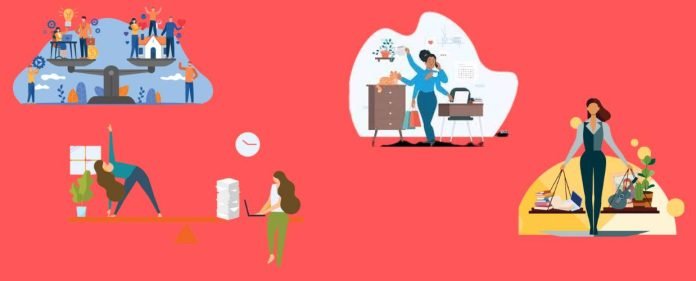In an age where technology has woven intricate threads of connectivity and the demands of modern life seem ceaseless, the quest for work-life balance has emerged as an emblematic challenge faced by individuals navigating the intricate tapestry of personal and professional responsibilities. This comprehensive exploration embarks on a journey to delve into the intricate concept of work-life balance, tracing its origins, unlocking its paramount significance, dissecting the profound implications of an imbalance, unveiling strategies for restoring equilibrium, and daring to envision a future where the boundaries between work and personal life merge harmoniously, fostering enhanced well-being, creativity, and productivity.
Origins and Essence
The origins of the work-life balance concept can be traced back to the Industrial Revolution, a pivotal point in history that witnessed the transformation of agrarian economies into industrial societies. This shift led to the delineation of work hours and a distinct separation between work and home life. Over time, as technological advancements and globalization sculpted the contours of the work landscape, the notion of work-life balance evolved, encompassing the intricate dance individuals perform to reconcile their professional commitments with their aspirations.
At its core, work-life balance encapsulates the aspiration to allocate time and energy judiciously to work-related responsibilities and personal interests. It embodies the pursuit of a lifestyle where neither realm dominates the other, allowing for the cultivation of physical, mental, and emotional well-being.
Significance of Work-Life Balance
The significance of work-life balance reverberates across multiple dimensions of an individual’s life, weaving its influence into the fabric of well-being, productivity, and relationships.
Physical and Mental Health
A harmonious balance between work and personal life nurtures physical health by carving out time for exercise, relaxation, and nourishment. It also nurtures mental well-being by providing the space to unwind, de-stress, and engage in activities that nurture the soul.
Enhanced Productivity
Contrary to the notion that longer work hours equate to heightened productivity, the research underscores that a balanced life contributes to enhanced focus, creativity, and efficiency in the workplace.
Nurturing Relationships
The delicate equilibrium between work and personal life serves as a fertile ground for nurturing relationships. The time invested in family and friends fosters emotional connections, reinforces support systems, and fosters a deeper sense of belonging.
Preventing Burnout
The relentless pursuit of professional endeavors without consideration for personal well-being can lead to burnout, characterized by emotional exhaustion and decreased job performance. Work-life balance acts as a protective barrier against burnout, safeguarding mental and emotional health.
Impact of an Imbalance
The consequences of a work-life imbalance can reverberate across an individual’s life with far-reaching repercussions.
Stress and Health Issues
An overwhelming focus on work-related commitments can trigger chronic stress, potentially leading to a spectrum of health concerns such as anxiety, depression, and cardiovascular problems.
Strained Relationships
Neglecting personal relationships due to unrelenting work demands strains familial and social bonds, eroding the foundation of a robust support system crucial for holistic well-being.
Diminished Productivity
The relentless pursuit of work can lead to cognitive fatigue, stifling creativity and ultimately leading to diminished job performance and productivity.
Eroding Enjoyment
Neglecting personal interests and hobbies can usher in a sense of dissatisfaction and monotony in life, ultimately impacting the overall quality of life and individual fulfillment.
Strategies for Achieving Work-Life Balance
Strategically crafting a work-life balance necessitates the harmonization of various facets.
Setting and Upholding Boundaries
The cornerstone of achieving work-life balance lies in setting and consistently upholding clear boundaries between work and personal life. Defining specific work hours and actively allocating time for leisure activities fosters a structured routine that respects both domains.
Prioritizing Tasks
Discerning between urgent and important tasks is pivotal. Prioritizing tasks aligns with personal and professional goals, allowing individuals to focus their energy on endeavors that truly matter while delegating or eliminating tasks that do not resonate with their aspirations.
Digital Detox
A conscious effort to detach from work-related devices and emails during personal time creates a psychological space to recharge and prevent burnout. Setting designated times for email checking and disconnecting from digital platforms promotes mental clarity and rejuvenation.
Embracing Self-Care
A key pillar in achieving balance involves prioritizing self-care. Engaging in regular exercise, mindfulness practices, pursuing hobbies, and dedicating time to loved ones replenishes physical, mental, and emotional reserves, nurturing holistic well-being.
Envisioning a Balanced Future
As technology continues to reshape the world, the future of work-life balance paints an intriguing canvas of possibilities.
Flexible Work Arrangements
The rise of remote work and flexible scheduling empowers individuals to customize their work hours, enabling them to strike a harmonious balance between professional commitments and personal interests.
Wellness-Centric Organizations
Forward-thinking organizations will place a premium on employee well-being, offering comprehensive wellness programs, mental health resources, and strategies that foster a conducive environment for achieving work-life harmony.
Outcome-Oriented Approach
The shift from monitoring hours worked to evaluating the quality and impact of output will define the workplace of the future. This transformation cultivates a culture where productivity is measured by meaningful contributions rather than hours clocked.
Integration into Education
The educational landscape will integrate the essence of work-life balance into curricula, nurturing holistic learning that prepares future generations to lead balanced, fulfilled lives in an increasingly interconnected world.
Conclusion: Crafting Equilibrium in a Dynamic Epoch
The pursuit of work-life balance stands as a testament to the innate human desire for equilibrium, transcending cultural, geographical, and professional boundaries. As the world evolves, achieving work-life balance emerges as a paramount asset.
By acknowledging the profound significance of balance, comprehending its manifold impacts, and steadfastly implementing strategies to restore and maintain it, individuals can weave a life where the pursuit of professional aspirations and personal fulfillment coalesce seamlessly. In the realm of work-life balance, the horizon unfurls a tapestry resonating with the harmonious convergence of well-being, empowerment, and the transformative remaking of the very fabric of existence.



